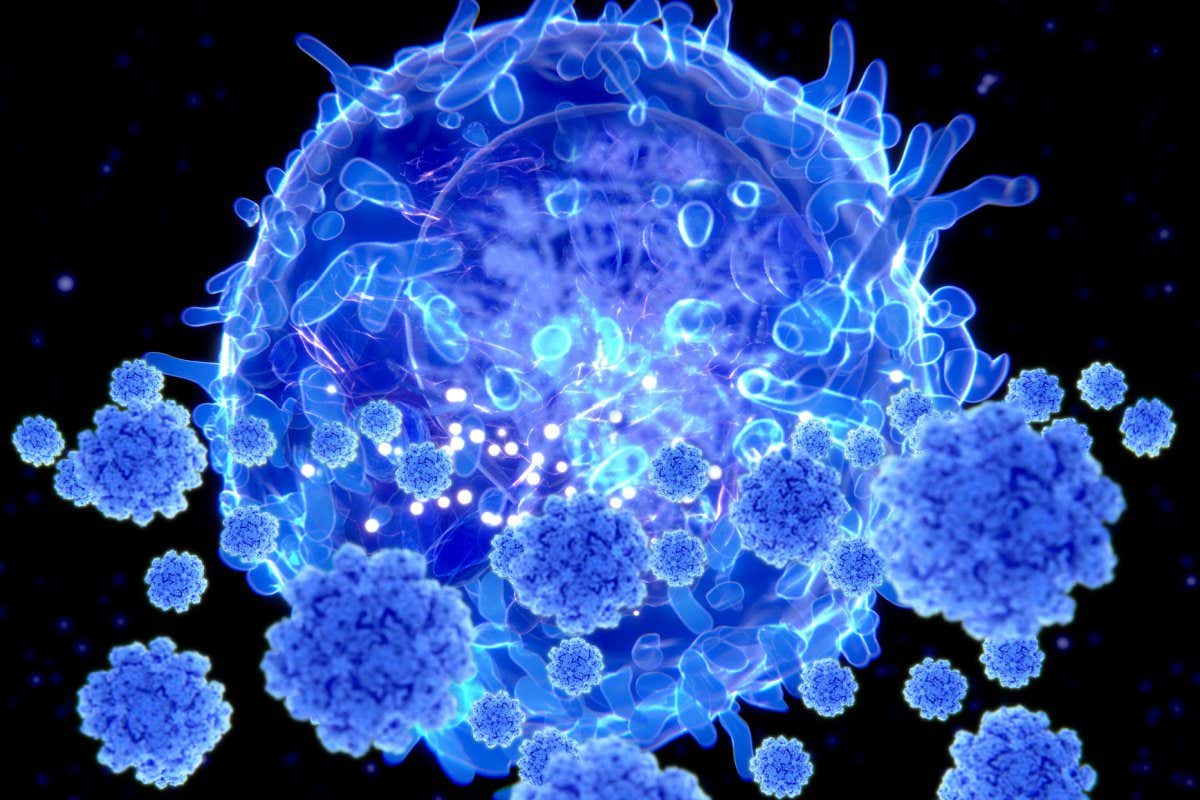Illustration of a T cell targeting SARS-CoV-2 particles
JUAN GAERTNER/SCIENCE PHOTO LIBRARY
Many groups worldwide are trying to develop vaccines that protect against a wide range of coronaviruses and prevent another pandemic. These efforts have now been boosted by the discovery that some healthcare workers had pre-existing immunity to the SARS-CoV-2 virus during the first wave of the pandemic.
During the first half of 2020, around 700 healthcare workers in the UK were tested weekly as part of a crowdfunded study called COVIDsortium. Most of these people, who wore protective equipment, never tested positive for covid-19 in PCR tests or developed covid-19 antibodies – proteins that bind to the outside of viruses, preventing cells from being infected.
However, when Leo Swadling and Mala Maini at University College London and their colleagues looked more closely, they found some of those who tested negative had a protein in their blood that is linked to covid-19 infection, as well as T cell responses to the SARS-CoV-2 virus. T cells are part of the immune system. It appears these people had what Swadling calls an “abortive infection”, where a strong, early T cell response enabled them to get rid of the virus very quickly.
Advertisement
Cells infected by viruses sound the alarm by displaying viral proteins on their surface, and T cells are the immune cells that learn to recognise these proteins and destroy infected cells. Crucially, while antibodies can only target proteins on the outside of a virus, T cells can learn to recognise any viral proteins.
When the team looked at early blood samples from the people who had an abortive infection, they found that even before being exposed to SARS-CoV-2, they had some T cells that could recognise the proteins that this virus uses to replicate itself inside infected cells.
The most likely explanation is that these people were often exposed to the existing human coronaviruses that cause around 10 per cent of colds, says Maini. “We don’t know the historic infections of these individuals, so we don’t know for sure where the T cells are coming from,” she says.
Preventing another pandemic
The proteins involved in viral replication are very similar in SARS-CoV-2 and other human and animal coronaviruses, meaning that if vaccines can be developed that elicit a strong T cell response against these proteins, they should protect against a very broad range of coronaviruses – a so-called universal or pan-coronavirus vaccine. One way to do this would be to add mRNAs coding for these proteins to mRNA vaccines that target the virus’s external spike protein.
Adding extra components to the next generation of coronavirus vaccines might protect both against any new variants that might evolve and against animal coronaviruses that could jump into people and spark a new pandemic, says Swadling. “There is a strong rationale for adding these proteins alongside the spike protein,” he says.
Many groups are already trying to develop coronavirus vaccines that provide broader protection, says Olga Pleguezuelos at UK-based company SEEK. Her team has already created such a vaccine based on the most conserved parts of coronavirus proteins. “It’s a matter of time before another of these members [of the coronavirus family] creates an epidemic or pandemic,” she says. “If we end up with something that is as infectious as covid and as lethal as MERS, then we are in serious trouble.”
However, it isn’t clear how effective a vaccine that only produces a T cell response would be, Maini says. Most vaccines work by stimulating an antibody response, though many do also produce a T cell response.
Many groups are developing universal flu vaccines based on eliciting a T cell response, but so far these haven’t proved highly effective. Other teams are instead focusing on getting antibodies to target parts of the outer viral proteins of the flu virus that don’t mutate. However, this won’t work with coronaviruses, says Peter Palese at the Icahn School of Medicine at Mount Sinai in New York. “They just don’t have a conserved region.”
Journal reference: Nature, DOI: 10.1038/s41586-021-04186-8
More on these topics:
































